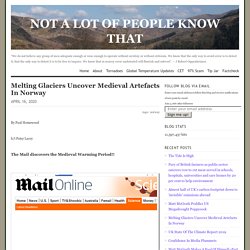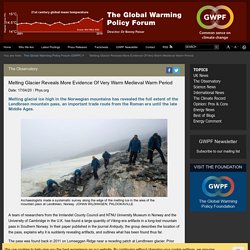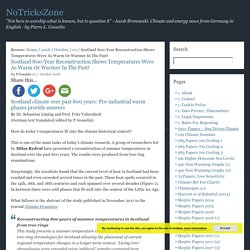

MWP: Glaciers. A 1200+ year reconstruction of temperature extremes for the northeastern Mediterranean region - Klippel - 2019 - International Journal of Climatology - Wiley Online Library. Supporting Information Figure S1 Coherence among (a) 100SP and (b) 10SP Pinus heldreichii MXD chronologies from the Katarapass (KAT), Mt Olympus (OLY), Mt.

Smolikas (SMO) in Greece, Sierra de Crispo (ITP) in Italy and the Vihren peak (VIH) in Bulgaria. Pairwise correlations were established for the individual common period with n > 10 series and over the common period 1769–1980. (c) Growth rates for the first 200 years (only living material considered) for the sites OLY, SMO and VIH. Material was split according to the measuring dates in 1981, 2008, 2010 and 2017 Figure S2 Density comparison between (a) living (red) and relict (green) material for the first and last 200 years of growth and (b) same as in a but additional data split by site. Figure S3 Correlations and partial correlations of the (a) 100SP and (b) 10SP chronology with climate data from the EOBS v. 15 grid 40.25°N and 20.75°E over the period 1950–2014.
Figure S4 Super epoch analysis. MWP In China. May 1, 2020 7:08 pm April ended up joint 5th mildest in the CET of 362 years, same as 1798, marginally cooler than 1865/1943.

Melting Glaciers Uncover Medieval Artefacts In Norway. By Paul Homewood h/t Patsy Lacey The Mail discovers the Medieval Warming Period!!

Melting glaciers in Norway have revealed ancient artefacts dropped by the side of a road more than 1,000 years ago. Clothes, tools, equipment and animal bone have been found by a team at a lost mountain pass at Lendbreen in Norway’s mountainous region. A haul of more than 100 artefacts at the site includes horseshoes, a wooden whisk, a walking stick, a wooden needle, a mitten and a small iron knife.
Melting Glacier Reveals More Evidence Of Very Warm Medieval Warm Period. Melting glacial ice high in the Norwegian mountains has revealed the full extent of the Lendbreen mountain pass, an important trade route from the Roman era until the late Middle Ages.

A team of researchers from the Innlandet County Council and NTNU University Museum in Norway and the University of Cambridge in the U.K. has found a large quantity of Viking-era artifacts in a long-lost mountain pass in Southern Norway. In their paper published in the journal Antiquity, the group describes the location of the pass, explains why it is suddenly revealing artifacts, and outlines what has been found thus far. The pass was found back in 2011 on Lomseggen Ridge near a receding patch at Lendbreen glacier. Dry Hot North German Summers Were More Common 1000 Years Ago, Scientists Report. Dry summers were not rare 1000 years ago.

Researchers from the University of Greifswald’s research group ‘Landscape Ecology and Ecosystem Dynamics’ have been able to reconstruct 1000 years of the dry summer period in northern Germany. Beech forest – photo: Dr. Tobias Scharnweber. Medieval Warm Period confirmed via cave study of 3000 years of climatic variations. Remote cave study reveals 3000 years of European climate variation Roaring Cave in Scotland.

Historical Grape Harvest Dates Show Modern Temperatures No Warmer Now Than Most Of The Last 1,000 Years. Public domain photo.

Source here In a late February (2017) interview on a U.S. news program, mechanical engineer Bill Nye claimed that the settled science says humans have been warming the planet at a rate that is unnaturally and “catastrophically” fast since the year 1750 . “It’s a settled question. Another paper refutes the Mann made hockey stick – MWP was ≈1°C warmer than current temperatures. This new paper uses a rather unique proxy; high-resolution samples micromilled from archaeological shells of the European limpet, Patella vulgata.

Mr. Limpet would be proud. Now, even less credible than before (Photo credit: Wikipedia) A paper published this week in the journal Palaeogeography, Palaeoclimatology, Palaeoecology finds that the Medieval Warming Period “was warmer than the late 20th century by ~1°C.” Scotland 800-Year Reconstruction Shows Temperatures Were As Warm Or Warmer In The Past! By P Gosselin on 7.

October 2018 Scotland climate over past 800 years: Pre-industrial warm phases provide answers By Dr. Sebastian Lüning and Prof. Fritz Vahrenholt (German text translated/edited by P Gosselin) How do today’s temperatures fit into the climate-historical context? Tibetan Temperature Reconstruction Shows Medieval Warm Period Was Warmer Than Today! A team of scientists led by HE YuXin of the Department of Earth Sciences at the University of Hong Kong examined two lake cores extracted from the Tibetan Plateau in order to reconstruct the past temperature development.

Source: East_Asia_topographic_map.png: Ksiom, the GNU Free Documentation License, Version 1.2 The two cores coming from two different lakes go back 2600 and 2200 years respectively. Here’s the paper’s abstract (my emphasis): Considerable efforts have been made to extend temperature records beyond the instrumental period through proxy reconstructions, in order to further understand the mechanisms of past climate variability. Hottest year ever? Giant clam reveals Middle Ages were warmer than today.
While government science and media begin the ramp-up to claim 2014 as the “hottest year ever” China’s Sea’s biggest bivalve shows that the Middle Ages were warmer than today, when Carbon Dioxide was lower.